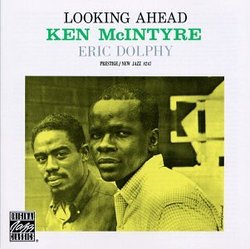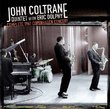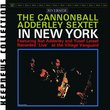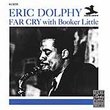| All Artists: Ken Mcintyre, Eric Dolphy Title: Looking Ahead Members Wishing: 5 Total Copies: 0 Label: Ojc Release Date: 3/10/1994 Genres: Jazz, Pop Styles: Avant Garde & Free Jazz, Modern Postbebop, Bebop Number of Discs: 1 SwapaCD Credits: 1 UPC: 025218625227 |
Search - Ken Mcintyre, Eric Dolphy :: Looking Ahead
 | Ken Mcintyre, Eric Dolphy Looking Ahead Genres: Jazz, Pop
|
Larger Image |
CD DetailsSimilar CDs
|
CD ReviewsMulti-multi-talented Frank Bock | 12/20/1999 (5 out of 5 stars) "We have here a meeting of two great multi-instrumentalists, Eric Dolphy and Ken McIntyre. Dolphy is of course the one we all know and love and for everyone who loves him, this is a classic, quite little known but fantastic session well worth picking up. And he is in great, cutting form as usual, mostly on alto (3 tracks) and flute (2) and bass clarinet (1). Ken McIntyre is more of an unknown. Also a giant multi-instrumentalist, McIntyre plays only alto sax and flute here, but later on would pick up the bass clarinet, oboe, and bassoon. His solos graced Cecil Taylor's brilliant, Unit Structures some years later. To his credit here, he sounds nothing like Dolphy though! You know, sometimes on Johnny Griffin's A Blowing Session, it's hard to distinguish between Griffin and Trane (and sometimes even Mobley! ) But not here... these two are very different, and together they sound great on the ensemble sections. Five of the six songs are McIntyre originals. Most of them are nice, and surprisingly quirky and memorable. They're all medium to fast tempo, with a nice light swing thanks to the top rhythm section of Walter Bishop (piano), Sam Jones (bass) and Art Taylor (drums). and of course Dolphy and McIntyre just cut things up! McIntyre is slower, dryer, and more careful that Dolphy who spins and jumps all over with his unique, loopy, bee-buzzing-in-a-jar style. But, McIntyre does some interesting things, and takes some tricky chances. One shouldn't downplay his contribution to this disk at all. Check out his solo on the last song, Dianna. His playing is gritty and experimental before giving way to Dolphy who rolls and sings notes on the flute. Overall, it's a great album. McIntyre is a very underrecorded voice so this album is somewhat essential. He sounds fresh and different throughout. And for Dolphy fans, this is of course essential. It won't be in constant rotation on your record player, but it's a good find." In Dolphy's shadow nadav haber | jerusalem Israel | 09/04/2002 (4 out of 5 stars) "While Eric Dolphy is heard on many recordings under his own name or as a sideman between the years 1960-1964 (when he died), Ken McIntyre is relatively an unknown name even to Jazz buffs. Hearing this CD indicates that Dolphy was a much more interesting soloist the McIntyre at the time. McItyre had an interesting intonation, but mostly he sounds very conservative. I have the feeling that he did not feel at ease with Parker's bop innovations, and was closer to pre-bop Jazz. This becomes very apparent when one hears Dolphy's solos - that show he absorbed Parker's style and took it one step further. It may be that McIntyre was a little awed by Dolphy's presence, but the result is that I find myself waiting for Dolphy's solos while McIntyre is playing. The rhythm section is good though a little too conservative for Dolphy. I recommand this CD for those who want to learn about McIntyre, but mostly for those who love Dolphy's wonderful playing." A bit schizophrenic.... Matthew Watters | Vietnam | 02/18/2009 (3 out of 5 stars) "What an odd session this was. On the one hand, you have a very tasteful, straightahead rhythm section of pianist Walter Bishop, bassist Sam Jones, and drummer Art Taylor. Taylor locks into a groove with his usual terrier-like tenacity, but also shows some of the lightness of touch he would show on records like Benny Golson's Free. He almost sounds like Roy Haynes, but it's still very much a mainstream performance. As for Bishop, well, he's almost the forgotten man in this line-up, but when he solos here, this album sounds like a great, lost piano trio. But then, on the other hand, you have the very idiosyncratic front line of Eric Dolphy and Ken McIntyre. As an alto player, McIntyre is pretty insufferable, with his "laughing" schtick wearing out its welcome pretty quick. Only on the two tracks which would have constituted Side B of the original LP, when he switches to flute, does he find a voice that is (a) pleasant and (b) appropriate to this rhythm section. That leaves Dolphy to try to stitch it all together. On Side B, he does. His alto solo on "Head Shakin'" is really a marvel, and he amazes as usual on bass clarinet on "Dianna." Side B really rates five stars. That leaves Side A, where Dolphy plays flute (his weakest axe) on the opening track and we get a two-alto front line on the remaining cuts, with both players trying to reach beyond the chord changes and add various vocalisms, all against that lovely, mainstream rhythm section. Side A is therefore pretty much a train wreck. Average rating: three stars."
|

 Track Listings (6) - Disc #1
Track Listings (6) - Disc #1

